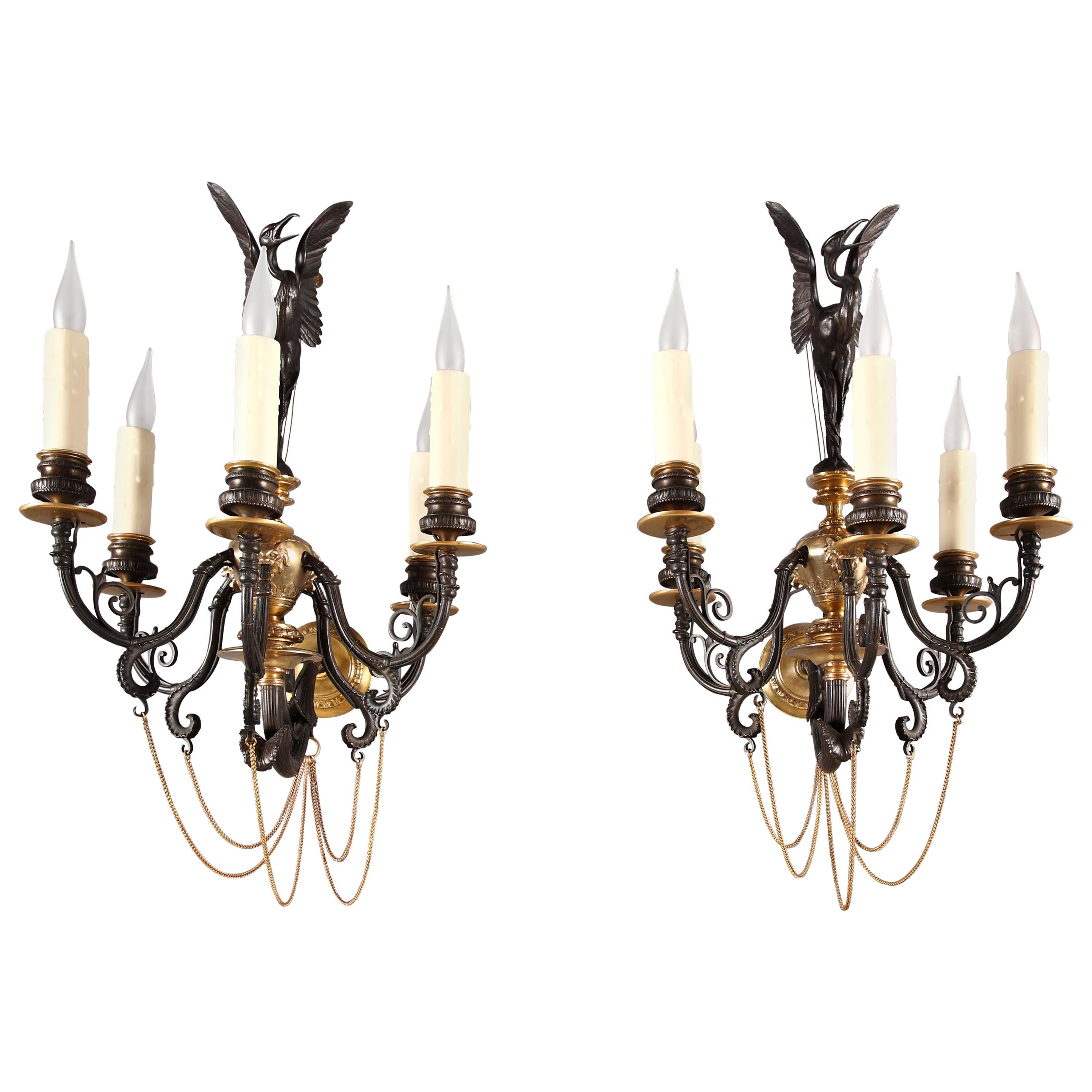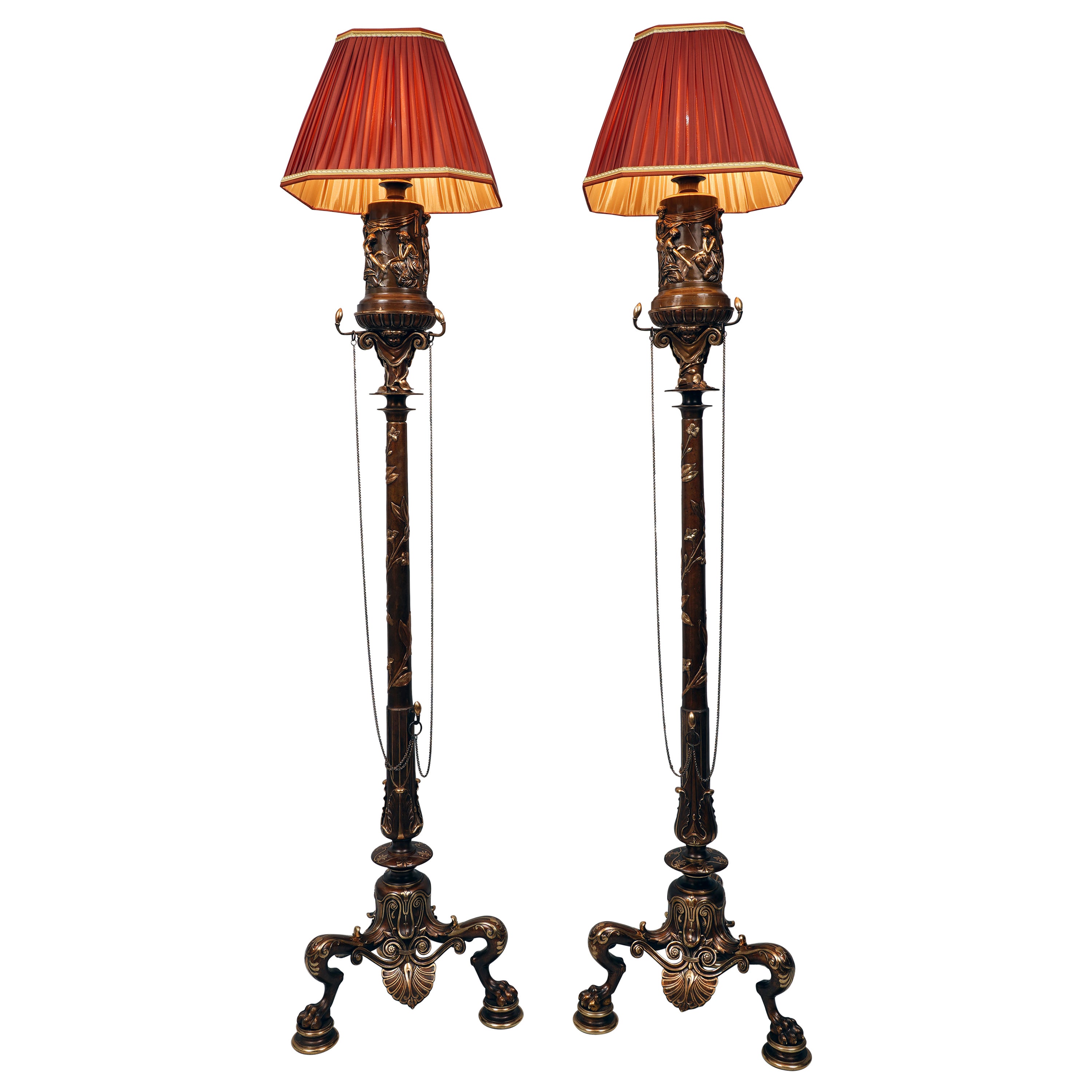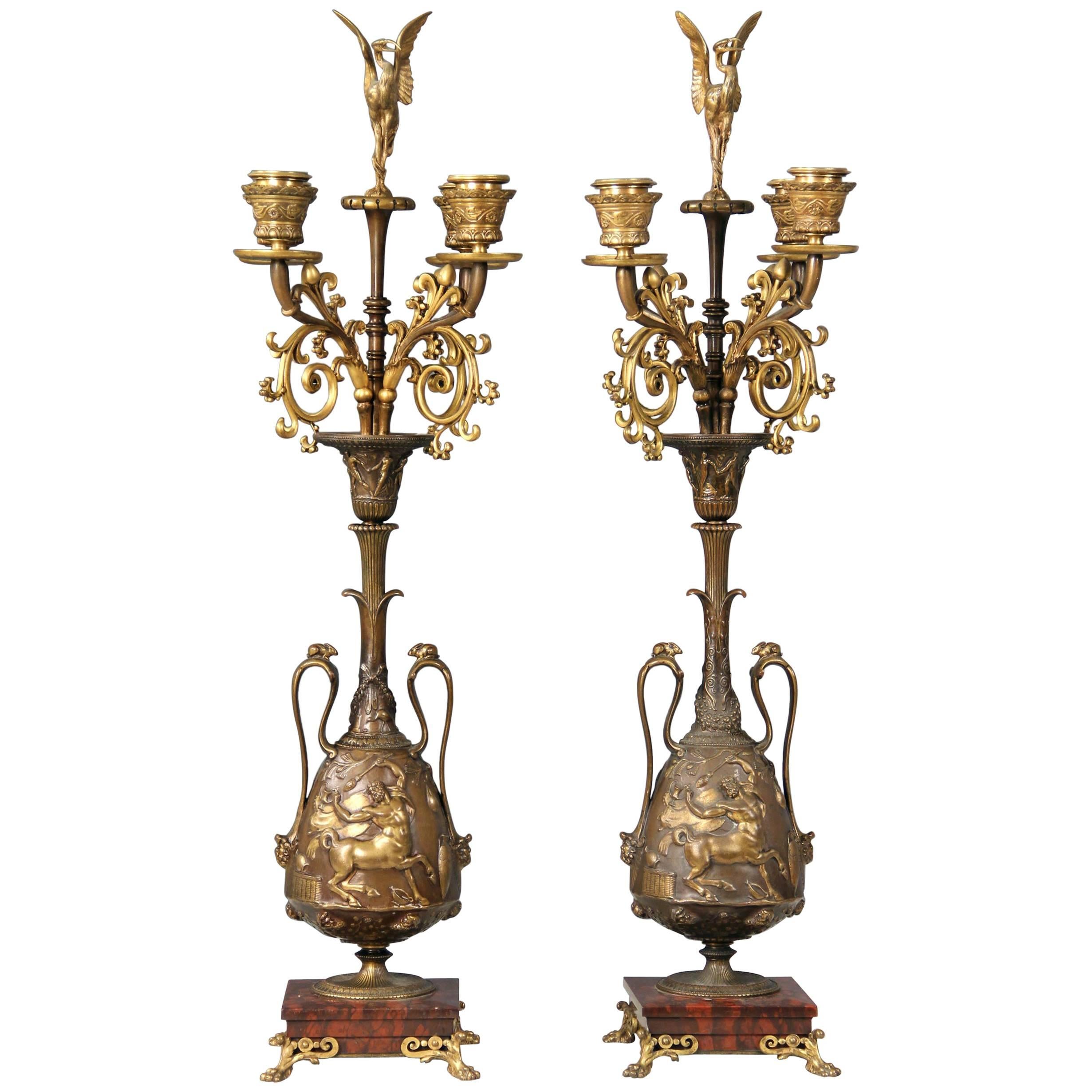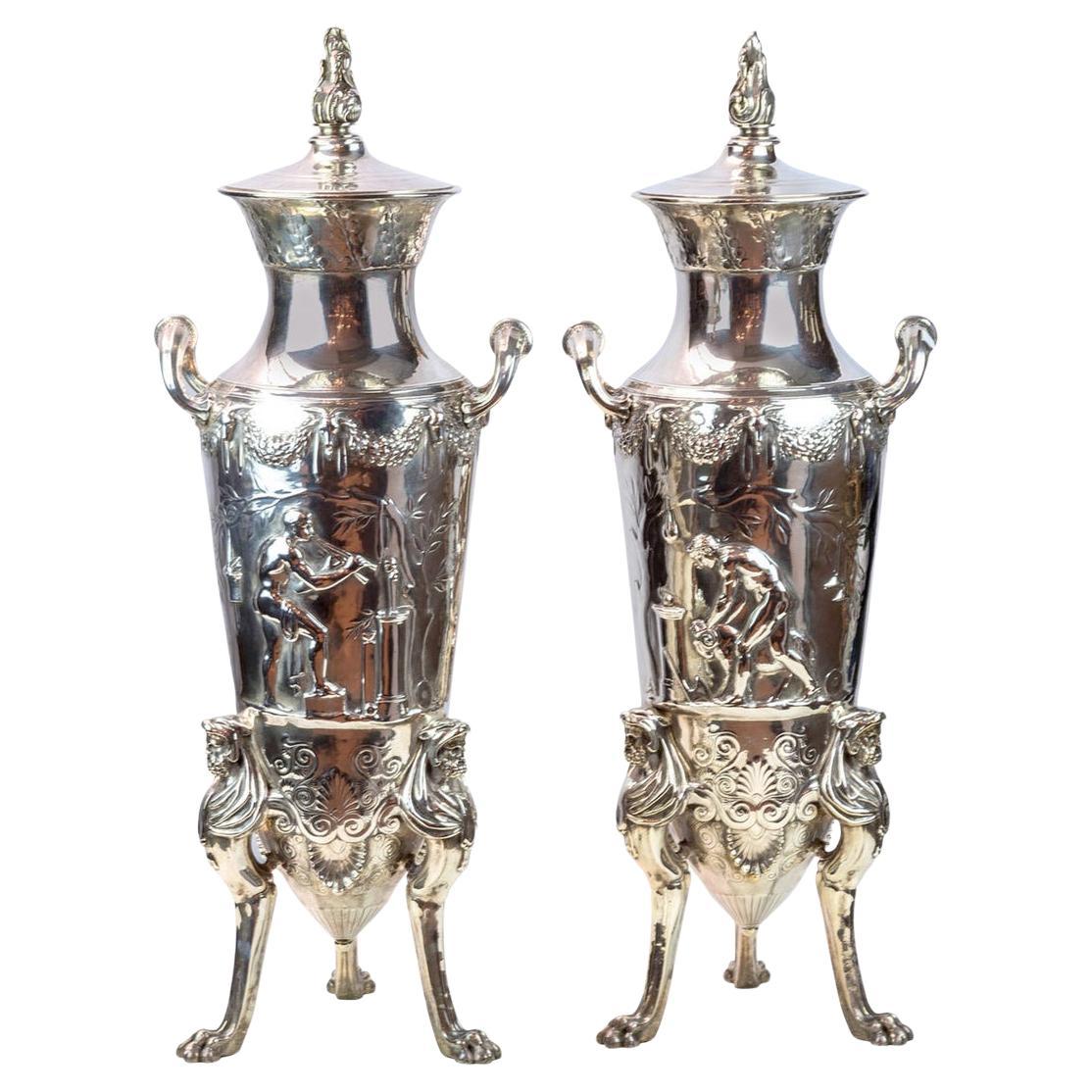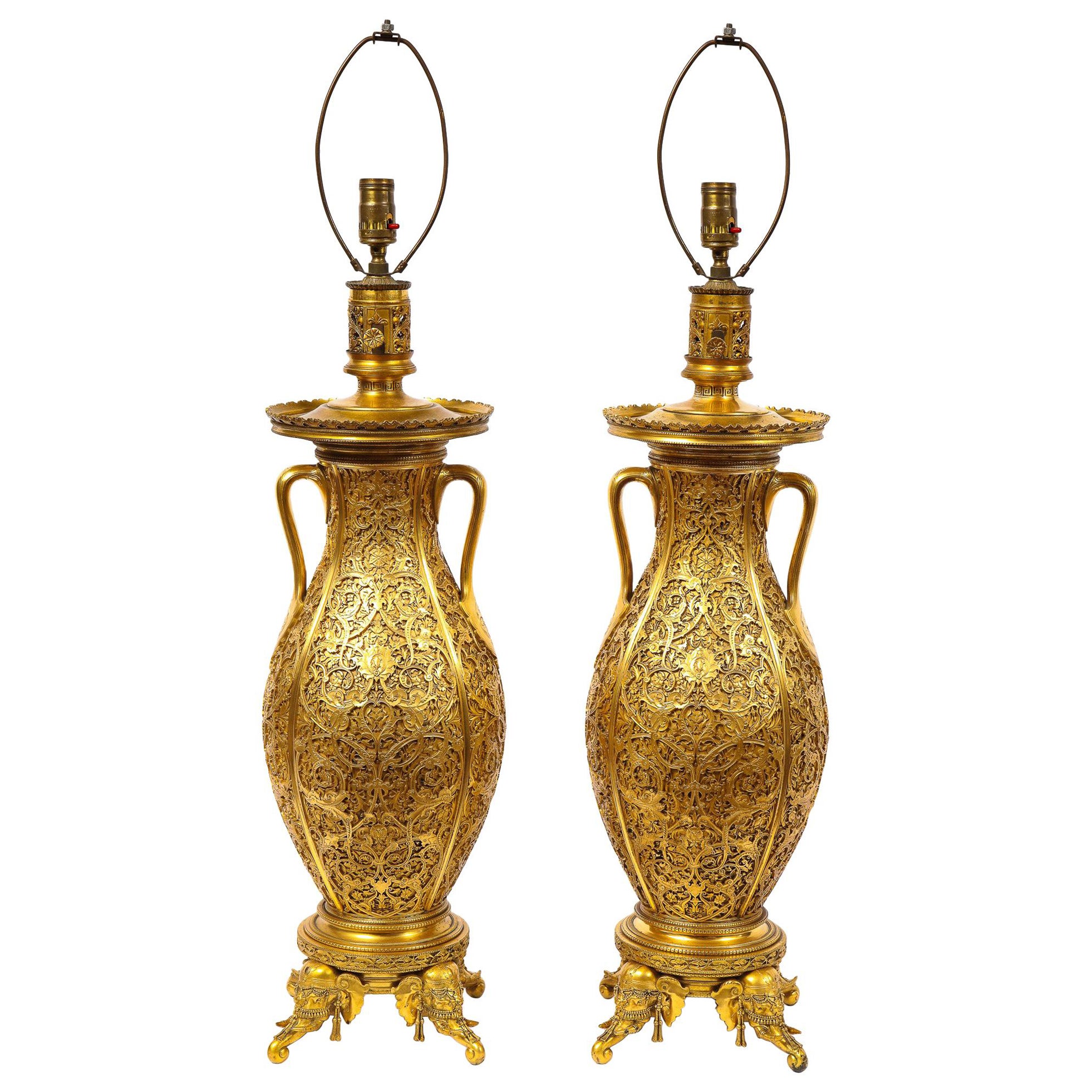Items Similar to Pair of Neo-Greek Vase-Candlesticks Attr. to Barbedienne and Levillain, c. 1880
Want more images or videos?
Request additional images or videos from the seller
1 of 7
Pair of Neo-Greek Vase-Candlesticks Attr. to Barbedienne and Levillain, c. 1880
About the Item
Pair of Greek style amphora shaped candlesticks made of gilded and patinated bronze attributed to F. Levillain and F. Barbedienne. Each flanked with two handles, and decorated with horsemen in relief. Standing on three lion’s feet headed with busts of putti and raised on a red griotte marble base.
Ferdinand Levillain (Paris, 1837-1905) studied under the sculptor Jouffroy (1806-1882), before making his debut in 1861 at the French Artists Salon where he continued to exhibit until 1903. At the 1867 Universal Exhibition in Paris, he was praised for a Neo-Greek style bronze cup he made for the firm Blot and Drouard. He was not to become really famous, however, until 1871 thanks to his association with the great bronze founder Ferdinand Barbedienne, who began to exhibit Neo-Greek style lamps, cups, vases and candelabra on his stands. Levillain was overwhelmingly triumphant at the 1878 Universal Exhibition in Paris, where he was unanimously awarded the gold medal for his creations in the Classical style. The famous bronze caster Servant (1828-c.1890) declared in the report of the jury for Artistic Bronzes that the work of Levillain “chased like the finest jewels” and “so diverse and pure of form (…) are of the highest degree of perfection”. After receiving a first class medal at the 1884 Salon for a cup entitled "The Elements, the Months and the Seasons", Ferdinand Levillain went on to win a silver medal at the 1889 Universal Exhibition in Paris.
Born in 1810, Ferdinand Barbedienne started one of the most famous 19th century artistic bronze casting companies. He died in 1892. In addition to his personal production, he worked for famous artists such as Clésinger, Carrière-Belleuse and Guillemin. Barbedienne’s production was always highly esteemed and he was, himself admired by contemporary art critics who compared him during the 1878 Universal Exhibition to a “prince of industry and the king of bronze-casting.” In the catalogue of the Exhibition, Barbedienne was considered as the leader among 19th century bronze casters, because of the exquisite quality of his bronzes.
- Attributed to:Ferdinand Barbedienne (Maker)Ferdinand Levillain (Sculptor)
- Dimensions:Height: 13.78 in (35 cm)Diameter: 4.73 in (12 cm)
- Sold As:Set of 2
- Style:Greek Revival (In the Style Of)
- Materials and Techniques:
- Place of Origin:
- Period:
- Date of Manufacture:circa 1880
- Condition:Wear consistent with age and use.
- Seller Location:PARIS, FR
- Reference Number:
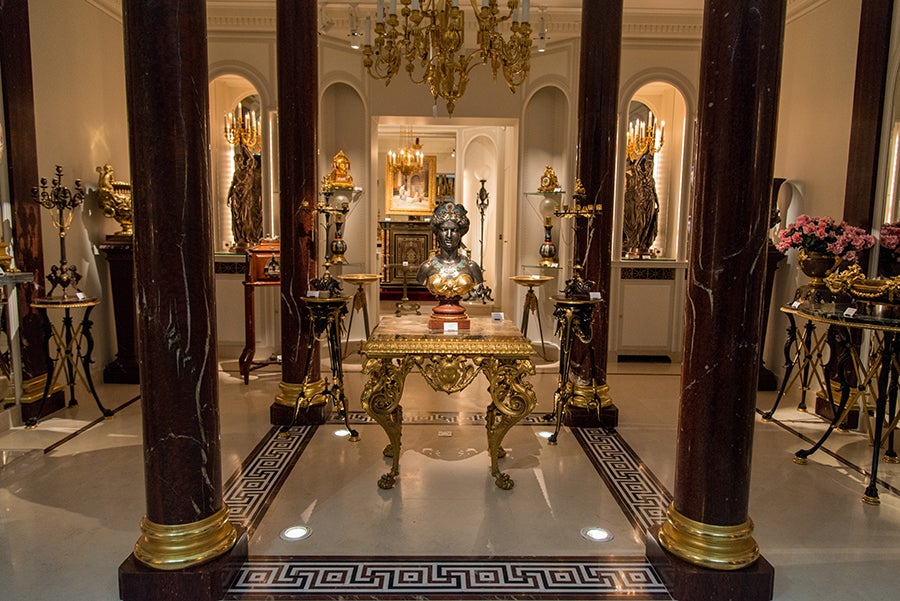
About the Seller
4.9
Vetted Seller
These experienced sellers undergo a comprehensive evaluation by our team of in-house experts.
Established in 1997
1stDibs seller since 2018
73 sales on 1stDibs
Typical response time: <1 hour
Associations
International Confederation of Art and Antique Dealers' Associations
- ShippingRetrieving quote...Ships From: PARIS, France
- Return PolicyA return for this item may be initiated within 7 days of delivery.
More From This SellerView All
- Pair of Neo-Greek Amphora Vases by Barbedienne and Levillain, France, circa 1880By Ferdinand Levillain, Ferdinand BarbedienneLocated in PARIS, FRPair of Greek style vases made two patina bronze. Each, designed in the shape of a tripod amphora adorned with Hercules heads, is decorated in low-relief...Category
Antique 1880s French Greek Revival Vases
MaterialsGriotte Marble, Bronze
- Fine Pair of Neo-Greek Vases by F. Levillain and F. Barbedienne, France, c. 1890By Ferdinand Levillain, Ferdinand BarbedienneLocated in PARIS, FRSigned F. Levillain sculpteur and F. Barbedienne. Pair of Greek style vases made of two patina bronze. Each, designed in the shape of a amphora resting on four hoof feet and a quadrilobed base, is decorated in low-relief with ancient times scenes of grape harvest and picking hops. Overleaf vases, profiles of gods Ariadne and Bacchus are ornated with grape vines and cornucopias. The handles are supported by two bearded heads of gods. Here is the model titled Amphore vendangeurs, modèle n°1 (68 cm), edited by Barbedienne after 1891. We find it in the catalogs until 1911. The figure of Bacchus is a subject dear to Ferdinand Levillain, which he exhibited bronze medallions in his first exposition as well as Universal Exhibitions in which he participated. Ferdinand Levillain (Paris, 1837-1905) studied under the sculptor Jouffroy (1806-1882), before making his debut in 1861 at the French Artists Salon where he continued to exhibit until 1903. At the 1867 Universal Exhibition in Paris, he was praised for a Neo-Greek style bronze cup he made for the firm Blot and Drouard. He was not to become really famous, however, until 1871 thanks to his association with the great bronze founder Ferdinand Barbedienne, who began to exhibit Neo-Greek style lamps...Category
Antique 1890s French Greek Revival Vases
MaterialsBronze
- Important Pair of Neo-Greek Vases by Levillain and Barbedienne, France, C. 1878By Ferdinand Levillain, Ferdinand BarbedienneLocated in PARIS, FRThe model of these Etruscan Amphoras has been exposed at the 1878 Paris Universal Exhibition. Each with a waisted neck raised with bearded satyr ma...Category
Antique 1870s French Greek Revival Vases
MaterialsMarble, Bronze
- Large Neo-Greek Vase by F. Levillain & F. Barbedienne, France, circa 1890By Ferdinand Barbedienne, Ferdinand LevillainLocated in PARIS, FRImportant neo-Greek vase in the shape of an Amphora, made in two patina bronze. The body is decorated with a rich continuous frieze in bas-relief presenting a procession of characters carrying their offerings to the temple, underlined by a decoration of theatrical masks among olive trees. The 's'-scroll handles decorated with grape vines, resting only on the shoulder of the vase, are supported by a ram’s head. Numerous palmettes and friezes adorn the whole. Resting on a molded marble circular base. Biography Ferdinand Levillain (Paris, 1837-1905) studied under the sculptor Jouffroy (1806-1882), before making his debut in 1861 at the French Artists Salon where he continued to exhibit until 1903. At the 1867 Universal Exhibition in Paris, he was praised for a Neo-Greek style bronze cup he made for the firm Blot and Drouard. He was not to become really famous, however, until 1871 thanks to his association with the great bronze founder Ferdinand Barbedienne, who began to exhibit Neo-Greek style lamps...Category
Antique 1890s French Greek Revival Vases
MaterialsMarble, Bronze
- Pair of Neo-Greek Gueridons Attr. to L.C Sevin & F. Barbedienne, France, c. 1880By Louis-Constant Sevin, Ferdinand BarbedienneLocated in PARIS, FRPair of patinated and gilded bronze high guéridon attributed to L.C Sevin and F. Barbedienne, with for each of them, three paw feet joined by X shaped stretche...Category
Antique 1880s French Greek Revival Gueridon
MaterialsGriotte Marble, Bronze
- Pair of Neo-Greek Wall-Lights Attributed to F. Barbedienne, France, Circa 1880By Ferdinand BarbedienneLocated in PARIS, FRA pair of neo-Greek wall-light sconces executed in two patina bronze attributed to F. Barbedienne. The central up-turned foliage stem, surmounted by a Greek style vase...Category
Antique 1880s French Greek Revival Wall Lights and Sconces
MaterialsBronze
You May Also Like
- Pair of Late 19th Century Napoleon III Candelabra by Levillian and BarbedienneBy Ferdinand Levillain, Ferdinand BarbedienneLocated in New York, NYA fine pair of late 19th century Napoleon III Rouge Griotte marble and patinated bronze four light candelabra Signed F. Levillian and F. Barbedienne Each surmounted by a stork,...Category
Antique Late 19th Century French Belle Époque Table Lamps
MaterialsMarble, Bronze
- A Very Fine Pair of Silvered Bronze Lamps attributed to Ferdinand LevillainBy Ferdinand LevillainLocated in New York, NYA Very Fine Pair of Silvered Bronze Lamps attributed to Ferdinand Levillain Origin: France Date: circa 1900 Dimension: H: 26 in. x W: 8.5 in. (dia)Category
Antique Early 19th Century French Table Lamps
MaterialsSilver, Bronze
- Pair of French Japonisme Ormolu Vases E. Lièvre, Executed by F. BarbedienneBy Edouard Lievre, Ferdinand BarbedienneLocated in New York, NYAn important and monumental pair of very fine 19th century French Japonisme/Orientalist ormolu vases designed by Edouard Lièvre and Executed by Ferdinand Barbedienne. Each body with an oval shape, finely sculpted in a floral design, fringed by orientalist style handles with cartouches, the neck surmounted by a circular pierced scrolling dragon frieze. Each vase resting on a group of four orientalist style jeweled elephant...Category
Antique 1870s French Japonisme Vases
MaterialsBronze
- Pair of Neo-Grec Style 3-Arm Dore Bronze and Enamel Candelabras, F. LevillainBy Ferdinand LevillainLocated in New York, NYA gorgeous and highly unique pair of 19th century French Neo-Grec style three-arm doré bronze and enamel candelabras, Attributed to Ferdinand Levillain, Stamped L C. Each candelabra ...Category
Antique 1880s French Greco Roman Candelabras
MaterialsBronze
- Barbedienne Bacchanalian Neoclassical Bronze Vase Mounted as LampBy Ferdinand BarbedienneLocated in New York, NYOur partially gilt bronze vase from Barbedienne was designed by Ferdinand Levillian (1837-1905), circa 1880s, and features a Roman scene and face of Bacchus on other side. Drilled f...Category
Antique Late 19th Century French Neoclassical Revival Table Lamps
MaterialsBronze
- Pair of 19th Century Rococo Ormolu & Griotte Marble Candelabra, BarbedienneBy Ferdinand BarbedienneLocated in Los Angeles, CAA fine pair of French 19th century Rococo Revival style gilt bronze and Rouge Griotte marble six-light candelabra attributed to Ferdinand Barbedienne (French, 1810-1892) After a mode...Category
Antique Late 19th Century French Rococo Revival Table Lamps
MaterialsGriotte Marble, Bronze, Ormolu
Recently Viewed
View AllMore Ways To Browse
Greek Pair
Greek Red
Greek Jewel
Greek Lamp
Furniture Of French Leaders
1880 French Lamp
Neo Lamp
Antique Lamp Company
Neo Classical Lighting
Work Table Casters
Neo Classical Lamp
Pair Tables Casters
Greek Style Lamp
French Pair Of Candlestick Lamps
Standing Lamp 19th
1905 Lamp
Pair Of Greek Lamp
Work Table With Casters
